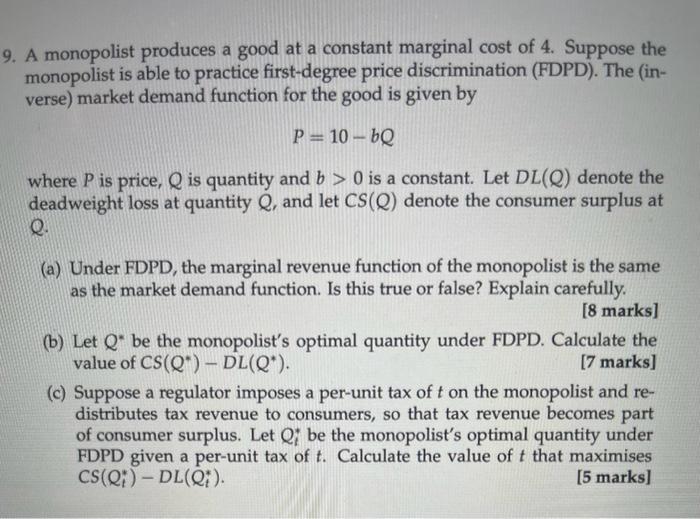Answered step by step
Verified Expert Solution
Question
1 Approved Answer
9. A monopolist produces a good at a constant marginal cost of 4. Suppose the monopolist is able to practice first-degree price discrimination (FDPD).

9. A monopolist produces a good at a constant marginal cost of 4. Suppose the monopolist is able to practice first-degree price discrimination (FDPD). The (in- verse) market demand function for the good is given by P=10-bQ where P is price, Q is quantity and b> 0 is a constant. Let DL(Q) denote the deadweight loss at quantity Q, and let CS(Q) denote the consumer surplus at Q. (a) Under FDPD, the marginal revenue function of the monopolist is the same as the market demand function. Is this true or false? Explain carefully. [8 marks] (b) Let Q be the monopolist's optimal quantity under FDPD. Calculate the value of CS(Q) - DL(Q*). [7 marks] (c) Suppose a regulator imposes a per-unit tax of t on the monopolist and re- distributes tax revenue to consumers, so that tax revenue becomes part of consumer surplus. Let Q be the monopolist's optimal quantity under FDPD given a per-unit tax of t. Calculate the value of f that maximises CS(Q)-DL(Q). [5 marks]
Step by Step Solution
★★★★★
3.40 Rating (159 Votes )
There are 3 Steps involved in it
Step: 1
a False Under firstdegree price discrimination the monopolist charges each consumer their maximum wi...
Get Instant Access to Expert-Tailored Solutions
See step-by-step solutions with expert insights and AI powered tools for academic success
Step: 2

Step: 3

Ace Your Homework with AI
Get the answers you need in no time with our AI-driven, step-by-step assistance
Get Started


